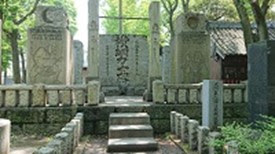It
weighs 20 tons with its height of 285 centimeters, width 288 and depth 51. ‘yokozuna
rikishi hi’ is inscribed in the center of the monument in thick Japanese
characters.
On
the back of the stone are inscribed the ring names of successive Yokozunas,
sumo grand champions.
Sumo
has a very long history in Japan. In mythical era, two strongest men had a battle
and Nominosukune won. Then he was enshrined as a god of sumo. In 9th
to 12th century sumo ceremony was held as a ritual at the imperial court. From
around 16th century warlords employed strong sumo wrestlers and
enjoyed watching their bouts.
But
there were other sumo wrestlers who were dismissed by their lords, or strong
farmers, firemen, etc. They had sumo bouts at a crossroads or on unoccupied grounds
surrounded by spectators. Even spectators could participate in the bout without
prior reservations. Spectators sat or stood around the sumo ground and bet
money on their favorite wrestlers. As there weren’t strict rules of wins and
losses at that time, fighting occurred frequently as to the result of the
match, causing injuries among wrestlers and spectators.
The
then government warried about those troubles and repeatedly banned the sumo
bouts.
After
Tomioka Hachimangu Shrine burned down by fire in 1682, they planned to hold a
fundraising sumo tournament at the venue to rebuild their shrine and asked
permission from the Edo government. The petition was granted in 1684. Because
lordless or jobless wrestlers must make a living, otherwise they might disturb
social order. Or because if entertainment-hungry people would throng to see the
sumo tournament, then the Shrine area would prosper and be developed, which was
a reclaimed land with a sparce population but rather near to the center of Edo
city across the Sumida River.
Officially
licensed grand sumo tournaments were held four times a year, two in Edo, one in
Kyoto and one in Osaka. In between 1684 and 1801, Tomioka Hachimangu Shrine
held about 50 fund raising sumo tournaments before the venue was moved to
Ryogoku Ekoin Temple.
It
is said that, at this time, strict sumo rules were made such as the size of the
ring, sumo wrestlers ranking list on one sheet of paper or winning techniques.
At
that time the highest sumo rank was Oozeki. Yokozuna was rather an
honorary rank although he must be strong enough.
First
‘yokozuna,’ a horizontal rope much like a sacred festoon in front of a Shinto
shrine, was awarded to Tanikaze Kajinosuke, then to Onogawa Kisaburo.
The
awarding ceremony was held at Tomioka Hachimangu Shrine.
In
Edo period (-1867), twelve sumo wrestlers were awarded Yokozuna titles.
In Meiji period (1868-1912), Jinmaku Kyugoro, the last Yokozuna in Edo period, planned to erect a monument to commemorate the great achievements of successive Yokozunas. After seven years of his effort, he could collect contribution from every field of life, and finally materialized his plan.
In
1900, a huge Yokozuna monument was erected in the back yard of the main building
of Tomioka Hachimangu Shrine.
For
the first time in sumo history, the number of generations were assigned to each
Yokozuna.
Before
deciding who was the first, second, third, or who really existed, or who was qualified
as a Yokazuna, Jinmaku widely sought information about former Yokozunas.
The
generation number is still inherited today. The latest Yokozuna, Terunofuji, is 73rd.
Please
come and see the huge Yokozuna monument at Tomioka Hachimangu Shrine. There is
also Ozeki Monument in the precinct nearby.
For
more information, please refer to our blogs, Ceremony to join list of
greatest sumo wrestlers at Tomioka Hachimangu Shrine, June 9, 2017 and
‘A History of Sumo’ Tour on June 24th, June 13, 2017
Note:
Today Yokozuna is the highest sumo rank and Ozeki is the next.
By
Hiroshi Nishitani


